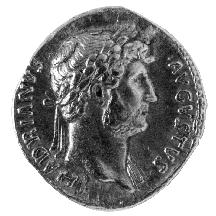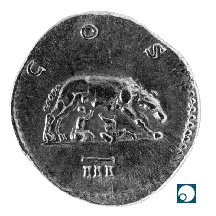



(92) Hadrian - AV aureus, A.D. 125-128, 7.28 g. (inv. 91.165).
Obverse: Laureate and draped bust of Hadrian r.; HADRIANVS
AVGVSTVS: Hadrianus Augustus.
Reverse: Wolf suckling Romulus and Remus; CO(N)S(VL) III:
consul for the third time.
Provenance: Münzen und Medaillen, 1976.
Bibliography: H. Mattingly and E.A. Sydenham, The Roman
Imperial Coinage II: Vespasian to Hadrian (London 1926) 192.
Hadrian (Publius Aelius Hadrianus) was a cousin of Trajan, who became his
guardian after the death of his father. He was an intellectual with a profound
love of Greek culture. Hadrian put an end to Trajan's expansionist policy
and spent much of his reign travelling the empire, consolidating its defenses
and supervising affairs in the provinces. He was a great builder whose contributions
to Roman architecture include the Pantheon in Rome and his magnificent villa
at Tivoli. He died in A.D. 138 and was immediately deified by the Senate.
Hadrian's portraits are an important turning point in the history of Roman
portraiture because he was the first emperor to wear a beard; almost all
emperors until the fourth century would do so as well. It was rumored that
he wore the beard to hide his bad complexion, but it was more likely an
adoption of Greek custom; he was a great patron of Athens, and he was nicknamed
Graeculus or Greekling for his love of the Greeks.
The reverse of this aureus refers to the legendary founding of Rome. It
depicts the twin founders of the city, Romulus and Remus, being suckled
by the she-wolf who found them after they had been abandoned. The type has
a long history in Roman coinage, beginning in the third century B.C. According
to the legend, Romulus and Remus were descendants of Aeneas, who had fled
the destruction of Troy and established a dynasty at Alba Longa in Italy.
Its last king was overthrown by his brother, who had the king's daughter
made a Vestal Virgin to ensure that she would have no heirs. When she did
have the twins by the god Mars, her uncle set them adrift on the Tiber.
They landed at the future site of Rome, where they were cared for by the
she-wolf until they were adopted and raised by a shepherd. When they were
grown they returned to Alba Longa, restored their grandfather to his throne,
and then set out to establish their own city. Romulus killed Remus in a
dispute and became the sole ruler of the city named after him.
K.S.



All contents copyright (c) 1996.
Lawrence University
All rights reserved.